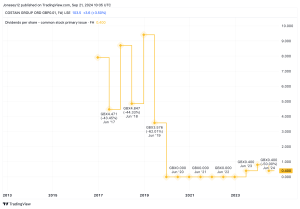It’s been a wild ride for Nvidia Corp (NASDAQ:NVDA) shares in recent days. Having briefly claimed the title of world’s most expensive company last Thursday, its valuation has plummeted by more than $500bn.
The chipmaker — which remains highly volatile in Tuesday pre-trading — has seen its market-cap topple back below $3bn, at $2.91bn. And it’s now behind Microsoft and Apple in the pecking order of the biggest US tech giants.
But what’s causing Nvidia’s share price to sink? And importantly for dip buyers, could this represent a good time to pile in?
Valuation worries
Concerns over Nvidia’s valuation seems to be the chief reason behind recent heavy selling.
Even now, Nvidia shares on an elevated forward price-to-earnings (P/E) ratio of 43.6 times. This remains far ahead of an average of 25.5 times for S&P 500 shares.
Many believe the rush for its shares — a symptom of the fresh craze for artificial intelligence (AI) stocks — led to an unjustifiably high valuation that’s now fuelling the correction.
According to Ross Mould of AJ Bell: “When everyone was piling into Nvidia, it created a sense of FOMO – fear of missing out – so others followed suit and bid up the shares even further. The same works in reverse, where a bout of selling can be exacerbated by others following the crowd and panicking.”
Profit-taking
Nvidia’s share price explosion of the last year has caused that valuation jump. Sure, the company’s down 16% from Thursday’s record highs of $140.76 pe share. But at $118.11, it remains a spectacular 190% more expensive than it was a year ago.
As a consequence, some investors are wishing to lock in profits ahead of the summer’s traditional market lull.
Hargreaves Lansdown analyst Derren Nathan comments that “it’s no surprise some investors are locking in some profits, including CEO Jensen Huang who is reported to have sold around $95m of stock in recent days.”
Natural volatility
Finally, it’s worth remembering that Nvidia is a naturally volatile stock, and that its recent extreme weakness is in part a product of this.
Right now, the company’s beta sits at 1.7. This is far ahead of the wider market’s reading of 1.0.
This means that Nvidia shares are expected to be 70% more volatile than the market.
So what next?
It’s worth remembering too that shares don’t travel in a straight line forever. And so Nvidia’s recent drop could be viewed as an inevitably. There’s certainly risk of additional weakness in the coming sessions.
Kathleen Brooks of XTB says that “there could be further downside to come, especially if investors are finally starting to get wary about paying up for AI.”
However, this doesn’t necessarily mean Nvidia’s a bad stock to buy. Brooks has also noted that the stock’s plunge into “correction territory [is] not driven by fundamental factors.”
Indeed, analysts have upgraded their profits estimates again following the firm’s blowout first-quarter results last month. In them, Nvidia reported a 262% annual surge in sales, another forecast-beating report that prompted brokers to predict mammoth earnings of $28bn this year.
As a long-term investor, Nvidia could still prove to be a great way to capitalise on the AI revolution. But buyers of its shares should be prepared to endure some pain along the way.
This post was originally published on Motley Fool







